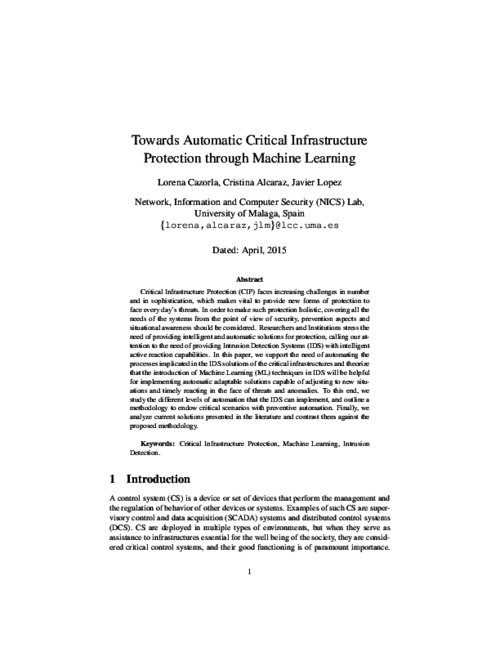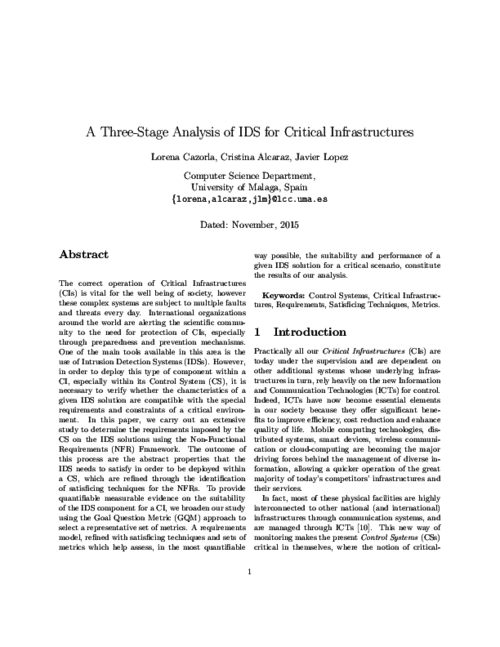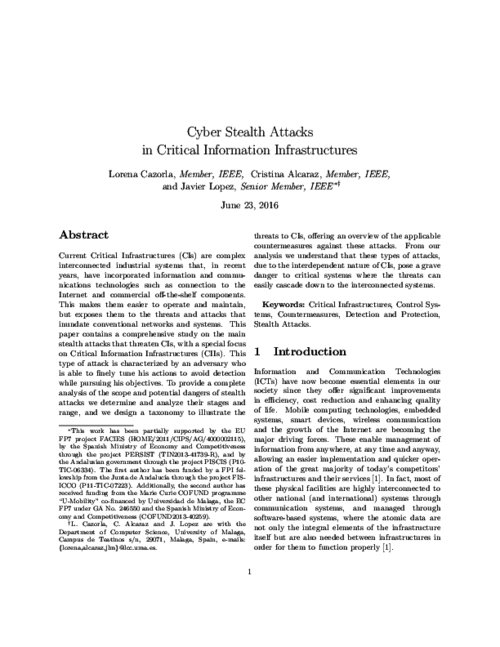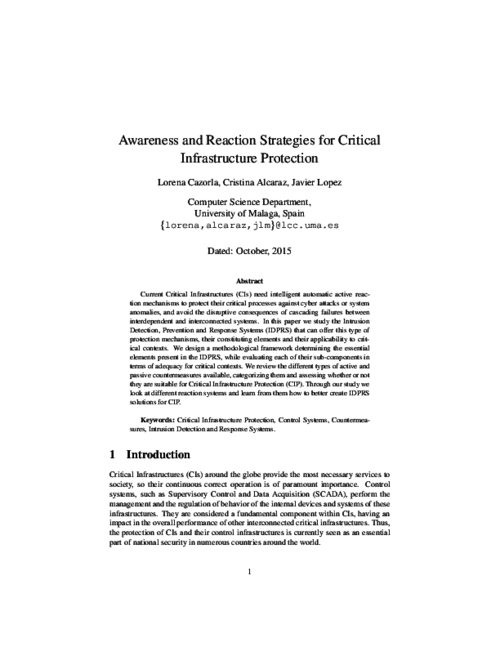8th International Conference on Critical Information Infrastructures Security, vol. 8328, Springer, pp. 197-203, 2013. DOI
Abstract
Critical Infrastructure Protection (CIP) faces increasing challenges in number and in sophistication, which makes vital to provide new forms of protection to face every day’s threats. In order to make such protection holistic, covering all the needs of the systems from the point of view of security, prevention aspects and situational awareness should be considered. Researchers and Institutions stress the need of providing intelligent and automatic solutions for protection, calling our attention to the need of providing Intrusion Detection Systems (IDS) with intelligent active reaction capabilities. In this paper, we support the need of automating the processes implicated in the IDS solutions of the critical infrastructures and theorize that the introduction of Machine Learning (ML) techniques in IDS will be helpful for implementing automatic adaptable solutions capable of adjusting to new situations and timely reacting in the face of threats and anomalies. To this end, we study the different levels of automation that the IDS can implement, and outline a methodology to endow critical scenarios with preventive automation. Finally, we analyze current solutions presented in the literature and contrast them against the proposed methodology

Computers & Security, vol. 55, no. November, Elsevier, pp. 235-250, 2015.
Abstract
The correct operation of Critical Infrastructures (CIs) is vital for the well being of society, however these complex systems are subject to multiple faults and threats every day. International organizations around the world are alerting the scientific community to the need for protection of CIs, especially through preparedness and prevention mechanisms. One of the main tools available in this area is the use of Intrusion Detection Systems (IDSs). However, in order to deploy this type of component within a CI, especially within its Control System (CS), it is necessary to verify whether the characteristics of a given IDS solution are compatible with the special requirements and constraints of a critical environment. In this paper, we carry out an extensive study to determine the requirements imposed by the CS on the IDS solutions using the Non-Functional Requirements (NFR) Framework. The outcome of this process are the abstract properties that the IDS needs to satisfy in order to be deployed within a CS, which are refined through the identification of satisficing techniques for the NFRs. To provide quantifiable measurable evidence on the suitability of the IDS component for a CI, we broaden our study using the Goal Question Metric (GQM) approach to select a representative set of metrics. A requirements model, refined with satisficing techniques and sets of metrics which help assess, in the most quantifiable way possible, the suitability and performance of a given IDS solution for a critical scenario, constitutes the results of our analysis.

IEEE Systems Journal, vol. 12, issue 2, IEEE, pp. 1778-1792, 06/2018. DOI
Abstract
Current Critical Infrastructures (CIs) are complex interconnected industrial systems that, in recent years, have incorporated information and communications technologies such as connection to the Internet and commercial off-the-shelf components. This makes them easier to operate and maintain, but exposes them to the threats and attacks that inundate conventional networks and systems. This paper contains a comprehensive study on the main stealth attacks that threaten CIs, with a special focus on Critical Information Infrastructures (CIIs). This type of attack is characterized by an adversary who is able to finely tune his actions to avoid detection while pursuing his objectives. To provide a complete analysis of the scope and potential dangers of stealth attacks we determine and analyze their stages and range, and we design a taxonomy to illustrate the threats to CIs, offering an overview of the applicable countermeasures against these attacks. From our analysis we understand that these types of attacks, due to the interdependent nature of CIs, pose a grave danger to critical systems where the threats can easily cascade down to the interconnected systems.

Computers and Electrical Engineering, vol. 47, issue October, Elsevier, pp. 299-317, 2015. DOI
Abstract
Current Critical Infrastructures (CIs) need intelligent automatic active reaction mechanisms to protect their critical processes against cyber attacks or system anomalies, and avoid the disruptive consequences of cascading failures between interdependent and interconnected systems. In this paper we study the Intrusion Detection, Prevention and Response Systems (IDPRS) that can offer this type of protection mechanisms, their constituting elements and their applicability to critical contexts. We design a methodological framework determining the essential elements present in the IDPRS, while evaluating each of their sub-components in terms of adequacy for critical contexts. We review the different types of active and passive countermeasures available, categorizing them and assessing whether or not they are suitable for Critical Infrastructure Protection (CIP). Through our study we look at different reaction systems and learn from them how to better create IDPRS solutions for CIP.

 ]
]